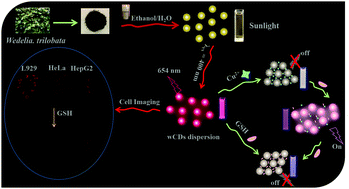Biomass carbon dots derived from Wedelia trilobata for the direct detection of glutathione and their imaging application in living cells†
Abstract
The development of long-wavelength emission carbon dots as a label-free sensing platform for the direct detection of glutathione (GSH) is still of great challenge. Herein, novel rose-red fluorescence carbon dots (wCDs) with a long-wavelength emission of 654 nm were successfully synthesized by a one-step microwave-solvothermal treatment of biomass Wedelia trilobata. The biomass-based wCDs could sensitively respond to copper ions (Cu2+) with a limit of detection (LOD) of 0.22 μM, which could be utilized as the fluorescence turn off–on sensor for the detection of GSH through recovering their fluorescence quenched by Cu2+. Moreover, the label-free wCDs with abundant active functional groups could be used to construct a direct quenching platform for the sensitive and selective detection of GSH by the dynamic quenching effect within 20 s without further modification, displaying a good linear range of 0–3.0 mM with a LOD of 35 μM that fits well with the GSH content in living cells (0.5–10 mM). Additionally, confocal imaging of living cells indicates that as-prepared wCDs with high photobleaching resistance and favorable biocompatibility possess the capacity for real-time monitoring of the variations of intracellular Cu2+ and GSH levels, and distinguishing cancerous cells from normal cells owing to the overexpression of GSH in cancerous cells. This study opens a new vision for developing an efficient and sensitive fluorescent sensor for the detection of GSH, and demonstrates the great prospects for wCDs in ion/molecule tracking, bioimaging and cancer diagnosis.



 Please wait while we load your content...
Please wait while we load your content...